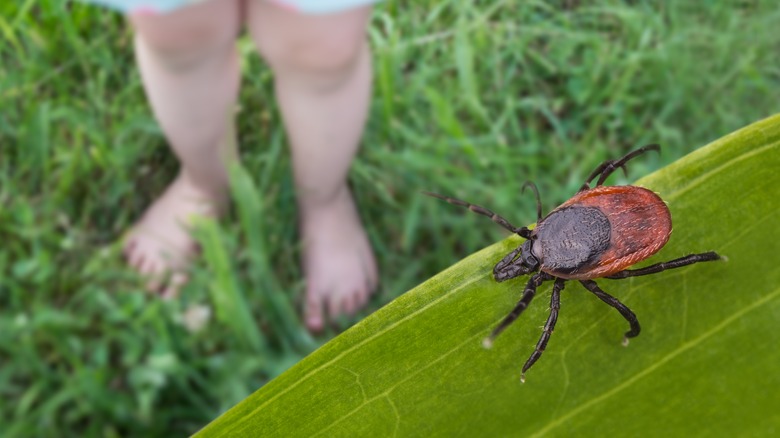Spraying This Chemical On Your Clothing Can Help Keep Ticks Away
Ticks are nasty irritating critters that can make even the most outdoorsy people regret spending time outside. It's hard to enjoy camping, hiking, or fishing when you risk these bloodsucking arachnids digging their heads into your veins and possibly imparting one of many tickborne illnesses into your body. While there are plenty of natural remedies to repel ticks touted online, most aren't strong enough to deter a tick that is intent on biting you — which is why they aren't recommended by the CDC. Even recommended repellents like DEET, picaridin, and oil of eucalyptus are actually more effective against mosquitoes than ticks. So, what works against ticks?
As it turns out, the solution may just be permethrin. Permethrin is a synthetic version of a pesticide that is naturally present in chrysanthemums (which are one of the garden plants that can help naturally repel ticks). Permethrin is recommended by the CDC and is different from other options because it kills ticks and mosquitoes as soon as they come in contact with the chemical instead of just repelling them. It is also quite effective. In fact, one study found that people with permethrin-treated shoes and socks were 74 times less likely to be bitten by ticks than those without treated footwear. So, if ticks are your enemy, then permethrin is your friend.
How to use permethrin to keep ticks away
It is important to know that, unlike DEET and other insect repellents, permethrin should never be applied to your skin. This is because permethrin is a chemical insecticide and can cause skin irritation and pain. Instead, permethrin needs to be sprayed onto your clothing. You can do this by hanging your clothes outside and spraying them with a permethrin-based repellent until they are damp. Then, allow the treated clothing to hang outside until completely dry. Once dry, you can safely wear the clothing. However, Consumer Reports notes that you should only treat your outer clothing layers and avoid treating any undergarments. You can also treat shoes and socks as well as gear like sleeping bags, tents, backpacks, and hammocks.
Permethrin-treated clothing can be effective against ticks and other insects for up to 40 days and it still works after being washed four times (it is recommended to reapply after the fifth wash). However, permethrin needs to be applied correctly to work well, so it is essential to follow all instructions on the label. If you want to skip the hassle of applying the chemical yourself, you can also purchase pretreated clothing.
The downsides of using permethrin
Although permethrin is the best defense we have against ticks, there are some downsides to using the product. Firstly, the chemical can be dangerous to pets — cats in particular. If you have cats, to avoid harming them or making them ill, it is important to keep them away from the area when you are applying permethrin to clothing and gear. Once the chemical is dry, it should be safe for feline companions.
Another downside of using permethrin is that you will likely have to use other repellents along with it to be fully protected. This is because permethrin can only be applied to clothing and any skin that isn't covered in treated material is free real estate. Therefore, to be fully protected, you will need to wear treated clothing and spray exposed skin with DEET or another repellent. And though we can try lots of things to avoid ticks, just in case, you should always carry a tick key with you while camping.
Lastly, as a pesticide, there are some environmental downsides to using this product. In fact, permethrin is not permitted for individual use against ticks in Canada because of its ability to harm beneficial insects like bees as well as birds and aquatic critters.


